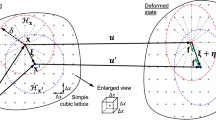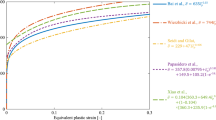Abstract
In some recent dropweight impact experiments [5] with pre-notched bend specimens of 4340 steel, it was observed that considerable crack tunneling occurred in the interior of the specimen prior to gross fracture initiation on the free surfaces. The final failure of the side ligaments happened because of shear lip formation. The tunneled region is characterized by a flat, fibrous fracture surface. In this paper, the experiments of [5] (corresponding to 5 m/s impact speed) are analyzed using a plane strain, dynamic finite element procedure. The Gurson constitutive model that accounts for the ductile failure mechanisms of micro-void nucleation, growth and coalescence is employed. The time at which incipient failure was observed near the notch tip in this computation, and the value of the dynamic J-integral, J d, at this time, compare reasonably well with experiments. This investigation shows that J-controlled stress and deformation fields are established near the notch tip whenever J d , increases with time. Also, it is found that the evolution of micro-mechanical quantities near the notch root can be correlated with the time variation of J d .The strain rate and the adiabatic temperature rise experienced at the notch root are examined. Finally, spatial variations of stresses and deformations are analyzed in detail.
Similar content being viewed by others
References
D.A. Shockey (ed.), in Metals Handbook, American Society of Metals, 9th edn., Vol. 8 (1983) 259–297.
A.H. Priest, in Proceedings of International Conference on Dynamic Fracture Toughness, Welding Institute, Cambridge, Paper 10 (1976) 95–111.
L.S. Costin and J. Duffy, Transactions ASME Series H Journal of Engineering Materials and Technology 101 (1979) 258–263.
J.R. Rice and N. Levy, in Physics of Strength and Plasticity, A. Argon (ed.), MIT Press (1969).
A.T. Zehnder, A.J. Rosakis and S. Krishnaswamy, International Journal of Fracture 42 (1990) 209–230.
A.T. Zehnder and A.J. Rosakis, Journal of Applied Mechanics 57 (1990) 618–626.
A.L. Gurson, Transactions ASME Series H Journal of Engineering Materials and Technology 99 (1977) 2–15.
J. Pan, M. Saje and A. Needleman, International Journal of Fracture 21 (1983) 261–278.
V. Tvergaard and A. Needleman, Acta Metallurgica 32 (1984) 157–169.
R. Narasimhan, A.J. Rosakis and B. Moran, International Journal of Fracture, to be published.
T. Nakamura, C.F. Shih and L.B. Freund, International Journal of Fracture 27 (1985) 229–243.
V. Tvergaard, in Advances in Applied Mechanics 27 (1990) 83–151.
S. Aoki, K. Kishimoto, A. Takeya and M. Sakata, International Journal of Fracture 24 (1984) 267–278.
N. Aravas and R.M. McMeeking, International Journal of Fracture 29 (1985) 21–38.
R. Becker, A. Needleman, S. Suresh, V. Tvergaard and A.K. Vasudevan, Acta Metallurgica 37 (1989) 99–120.
D.M. Norris, Engineering Fracture Mechanics 11 (1979) 261–274.
V. Tvergaard and A. Needleman, International Journal of Fracture 37 (1988) 197–215.
V. Tvergaard, International Journal of Fracture 17 (1981) 389–407.
T.B. Cox and J.R. Low, Metallurgical Transactions 5 (1974) 1457–1470.
L.M. Brown and J.D. Embury, in Microstructure and Design of Alloys, Proceedings of the Third International Conference on the Strength of Metals and Alloys, Cambridge, England (1973) 164–179.
H. Anderson, Journal of Mechanics and Physics of Solids 25 (1977) 217–233.
S. Tanimura and J. Duffy, International Journal of Plasticity 2 (1986) 21–35.
C.C. Chu and A. Needleman, Transactions ASME Series H Journal of Engineering Materials and Technology 102 (1980) 249–256.
K.J. Bathe, Finite Element Procedures in Engineering Analysis, Prentice Hall, Englewood Cliffs, New Jersey (1982).
T.J.R. Hughes, in Computational Methods for Transient Analysis, T. Belytshko and T.J.R. Hughes (eds.), Elsevier, Amsterdam (1983) 67–155.
T. Belytshko, in Computational Methods for Transient Analysis, Elsevier, Amsterdam (1983) 1–65.
D. Pierce, C.F. Shih and A. Needleman, Computers and Structures 18 (1984) 875–887.
V. Tvergaard, Journal of Mechanics and Physics of Solids 30 (1982) 399–425.
T. Nakamura, C.F. Shih and L.B. Freund, Engineering Fracture Mechanics 25 (1986) 323–339.
W. Böhme and J.F. Kalthoff, International Journal of Fracture 20 (1982) R139-R143.
J.W. Hutchinson, Journal of Mechanics and Physics of Solids 16 (1968) 337–347.
J.R. Rice and G.F. Rosengren, Journal of Mechanics and Physics of Solids 16 (1968) 1–12.
C.F. Shih, Tables of HRR Singular Field Quantities, Brown University Report (1983).
C.F. Shih, Journal of Mechanics and Physics of Solids 29 (1981) 305–326.
J.R. Rice and D.M. Tracey, in Numerical Methods in Structural Mechanics, S.J. Fenves (eds.), Academic Press, New York (1973) 585–623.
Aerospace Structural Metals Handbook, Metals and Ceramics Information Center, Battelle Columbus Laboratories, Columbus, Ohio (1989).
Author information
Authors and Affiliations
Rights and permissions
About this article
Cite this article
Jha, M., Narasimhan, R. A finite element analysis of dynamic fracture initiation by ductile failure mechanisms in a 4340 steel. Int J Fract 56, 209–231 (1992). https://doi.org/10.1007/BF00012328
Received:
Accepted:
Issue Date:
DOI: https://doi.org/10.1007/BF00012328




